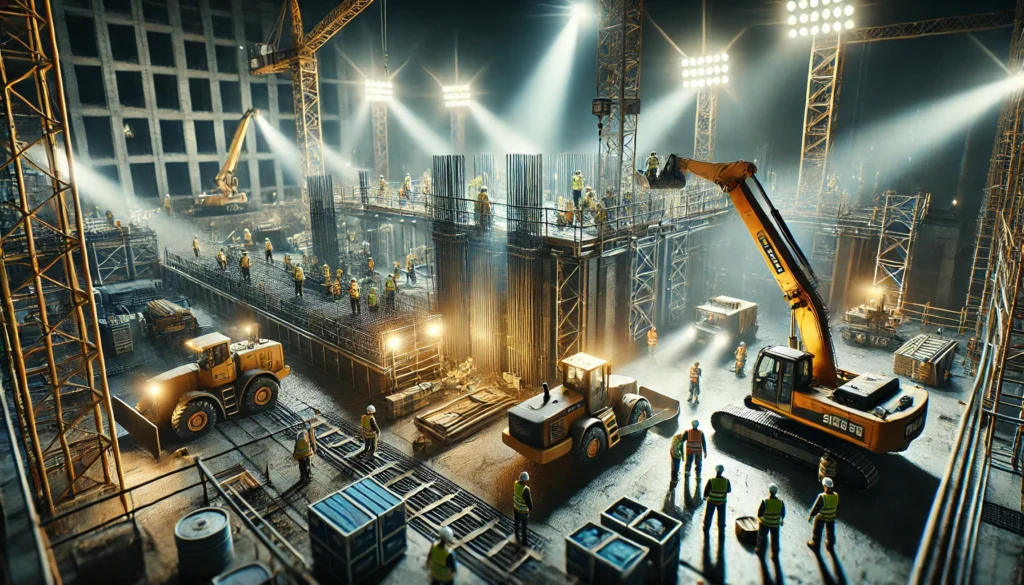The CIS 14:2019 – Guidelines on Construction Works at Night was developed by CIDB to address the growing need for construction activities during nighttime hours, especially in urban areas. Nighttime construction can help reduce traffic disruptions and meet tight project deadlines, but it also introduces additional safety risks. This guide outlines best practices for planning, safety management, and hazard control to ensure the safety of workers and the public.
Introduction to Night Construction
Night construction, while necessary for many projects, comes with inherent dangers due to limited visibility and other challenges. The CIS 14:2019 guidelines provide comprehensive solutions for reducing these risks and ensuring compliance with relevant safety regulations, including the Occupational Safety and Health Act (OSHA) 1994 and the Factories and Machinery (Building Operations and Works of Engineering Construction) (BOWEC) Regulations 1986.
Key Objectives of Nighttime Construction Safety Guidelines
The primary objective of the guidelines is to protect both workers and the public from potential hazards during nighttime construction activities. Specific goals include:
- Minimizing Risks: The guidelines help contractors identify and control hazards like poor visibility, fatigue, and equipment-related incidents.
- Improving Planning: Proper planning for construction work at night, including obtaining permits and preparing emergency response plans.
- Ensuring Compliance: Contractors must adhere to local safety and health regulations, including those outlined in the Factories and Machinery Act 1967 and Road Transport Act 1987.
Planning for Night Construction
Planning is crucial for minimizing risks during nighttime construction. Key components of a solid safety management plan include:
1. Safety Management Plan:
- Each construction site must have a documented safety management plan. This plan should outline the roles of all personnel, including project managers, site supervisors, and safety officers, who must ensure safety is a top priority.
- Safety equipment inventory should be regularly checked and updated to include reflective signage, barriers, and lighting systems.
2. Approvals and Permits:
- Contractors must obtain necessary permits from local authorities before beginning nighttime work. Compliance with all requirements is mandatory.
3. Hazard Identification and Risk Assessment (HIRARC):
- Conduct a detailed risk assessment for nighttime activities. Common hazards include falls from height, moving machinery, fatigue, and insufficient lighting.
- Control measures should be implemented based on the hierarchy of controls, from eliminating the hazard to using personal protective equipment (PPE).
General Safety and Health Precautions
Several general safety and health measures must be taken to ensure the well-being of workers and minimize accidents during nighttime construction:
1. Proper Illumination:
- Adequate lighting is essential to ensure safety and efficiency. The guidelines categorize illumination into three levels, depending on the type of task:
- Category 1 (54 lux): General site illumination for slow-moving equipment and low-accuracy tasks.
- Category 2 (108 lux): Areas with construction equipment and medium-accuracy tasks.
- Category 3 (216 lux): High-accuracy tasks such as crack filling and maintenance of electrical connections.
- Reflective clothing, proper illumination of the work area, and lighted signage should be used to improve worker visibility.
2. Visibility of Workers and Vehicles:
- Workers should wear high-visibility apparel that includes retro-reflective materials visible from 300 meters. Similarly, vehicles must have flashing amber lights to enhance their visibility.
- Clear signage and barriers must be installed to protect both workers and the public.
3. PPE and Site Safety:
- Workers should be equipped with helmets, safety shoes, and reflective vests. Flashlights should be provided in poorly lit areas, and emergency tools like whistles should be available.
Traffic and Public Safety Measures
In road construction at night, ensuring public safety is critical. The guidelines provide recommendations for traffic management and public safety:
1. Traffic Management Plan:
- A well-designed traffic management plan should include advance warning zones, buffer areas, and work area protection barriers. The plan must be approved by local authorities before work begins.
2. Temporary Barriers and Traffic Cones:
- Use retro-reflective materials on barriers and cones to ensure visibility. Barriers should be properly anchored and illuminated.
3. Emergency Response Plan (ERP):
- Every site should have an ERP tailored to nighttime operations, with trained staff, emergency contact numbers, and designated evacuation routes. Regular emergency drills must be conducted to prepare workers for potential hazards.
Noise and Vibration Control
Nighttime construction often causes noise and vibration, which can affect both workers and nearby residents. Contractors must:
- Follow environmental noise limits as outlined in Annex C of the guidelines, which provides maximum permissible noise levels for different areas.
- Implement noise control measures such as using quieter equipment, placing barriers around noisy machinery, and scheduling noise-intensive tasks during less sensitive hours.
Conclusion: Implementing SHASSIC for Night Construction
To further improve safety, contractors can implement the Safety and Health Assessment System in Construction (SHASSIC), which evaluates the effectiveness of safety measures in place. SHASSIC provides a clear star rating system that demonstrates a company’s commitment to safety.
The CIS 14:2019 guidelines are an essential tool for ensuring that nighttime construction projects are carried out safely and efficiently. By following these best practices, contractors can minimize risks, comply with regulations, and protect both workers and the public.


